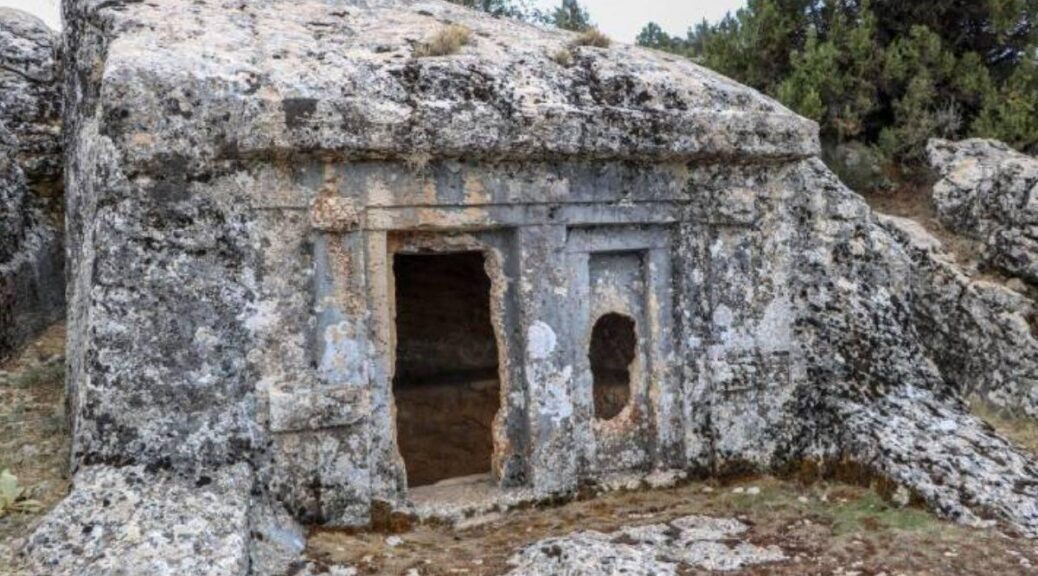Treasure hunters explode 2500-year-old Lycian Rock-cut Tombs in Turkey
Treasure hunters have exploded the entrance of a 2,500-year-old rock-cut tomb, one of the six ancient sepulchres in the Elmalı district of the southern province of Antalya.
“These are cultural heritages, we must protect them to leave to the next generations,” Durmuş Altan, an archaeologist, told Demirören News Agency on Oct. 6.
According to Altan, who is also the head of the provincial directorate of cultural and social affairs, there are six rock tombs in the neighbourhood.
“Four of them are from the Lycian period,” he said and added: “Today’s Armutlu was in the territory of the then Lycia Kingdom.”
“The meticulous cut of the rock tombs shows that there was once a genuine settlement in the area,” he added.
But the latest state of the rock tombs is not pleasant. Doomed to their destiny, the rock tombs were damaged with writings on them.
Treasure hunters recently flattened the entrance of a rock tomb with explosives, the archaeologist noted.

“They think they can find sculptures or gold here in the region. These people, unfortunately, damage the cultural assets,” he added.
Few written records remain from the distinctive Lycian culture.
Lycia was located in the region that is now the Antalya and Muğla provinces, on Turkey’s southern coast, and also in Burdur province, which lies further inland. Given that there are few written records left by the ancient Lycians, not much is known about the civilization. What we do know is that they had a distinct culture that had unique aspects not found elsewhere in the ancient world.
One of the most extraordinary aspects of Lycian culture was the striking tombs they built and Ancient Origins wrote a great article about these remarkable tombs a few years ago.
The Lycians made rock-cut, sarcophagus, and pillar tombs. Of these three known types, rock-cut tombs are the most common. The earliest Lycian rock-cut tombs dating to the 5th century BC.
The Lycians believed that a mythical winged creature would carry them into the afterlife, and this is perhaps one of the reasons their tombs were carved directly into rock faces, often a cliff.
Fascinatingly, the Lycian tombs were usually carved to resemble the façade of their houses. They often had one or two stories and sometimes even three. The tombs sometimes held more than one body, most probably of people related to each other, thus extending family ties into the afterlife.
The mythological reliefs sometimes carved on the rock-cut tombs also tell us something about their religious beliefs. The Lycian tombs, rock-cut or otherwise, are thus a precious relic of an ancient culture that has not left behind many written records to help us understand them better. Archaeologist Durmuş Altan’s distress at the callous damage done to one of them by treasure seekers is, therefore, most understandable.
READ ALSO: 1,800-YEAR-OLD ROCK TOMBS FOUND IN TURKEY’S ANCIENT CITY BLAUNDUS
Of course, this is not the first time that ancient tombs and monuments have been broken open by treasure hunters. Tomb robbery goes all the way back to antiquity and has occurred all over the world.
One of the most well-known examples is from Egypt where most of the tombs in the Valley of the Kings were looted within a hundred years of their being sealed. In modern times, robbing ancient tombs is sometimes the work of organized gangs.
It is hoped that episodes like the latest tomb raid in Elmali will be prevented in future by greater cooperation between governments, UNESCO, and other world heritage bodies. As Altan stated, these are sacred heirlooms, and we owe it to future generations to leave them in even better shape than we found them ourselves.
